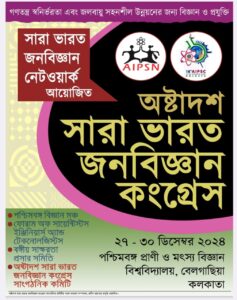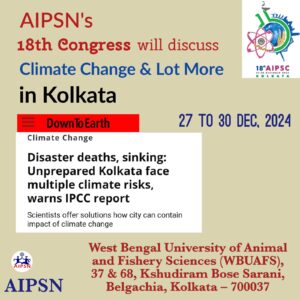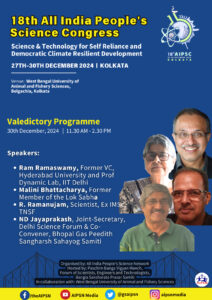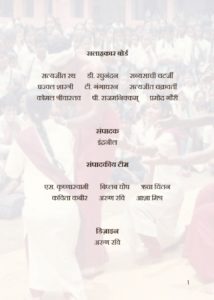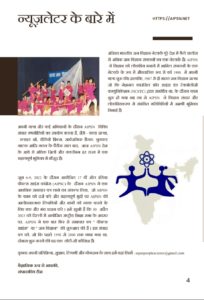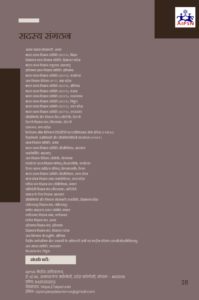19 Aug 2024
National Scientific Temper Day 2024
Advocating Scientific Integrity and Unhindered Rational Inquiry
The 7th National Scientific Temper Day (NSTD 24) will be observed across the nation on August 20, 2024, to honour Dr. Narendra Dabholkar, a notable proponent of science and rational thought, who was tragically killed on this day in 2013 by anti-science extremists. His assassination was followed by the murders of others equally vocal and of similar thinking – Govind Pansare, M.M. Kalburgi, and Gauri Lankesh – who were also murdered. In 2018, the All India People’s Science Network (AIPSN), in collaboration with the Maharashtra Andhshraddha Nirmulan Samiti (MANS), established National Scientific Temper Day (NSTD) as an annual event to commemorate these individuals and to promote a scientific mindset.
Upholding Constitutional Values:
Since its establishment, NSTD has received considerable support from a variety of groups and individuals throughout India, with events occurring in numerous regions. This year’s emphasis is on the Kolkata 2024 Declaration on Scientific Temper, which underscores the urgent need for a renewed commitment to evidence-based reasoning and critical analysis in India. This is especially crucial in light of emerging socio-political movements that challenge scientific inquiry and the generation of universal knowledge. The Kolkata Declaration highlights three primary areas for focus: the role of government, the responsibilities of scientific and educational institutions, and the necessity to combat the erosion of academic freedom and the proliferation of pseudo-science. It calls upon scientists, intellectuals, and advocates promoting evidence-based thinking and upholding constitutional values, thereby fostering a scientific perspective.
NSTD also includes the “Ask Why?” campaign, which aims to advance scientific temper and promote Article 51A (h) of the Indian Constitution. This initiative seeks to reinforce the constitutional right to scientific inquiry and to enhance investment in employment; people centred development, education for all, science, technology, humanities, and the arts.
Interplay of Politics and Education:
Concerns are mounting regarding the influence of Hindutva-related initiatives within research institutions and universities, reflecting a significant political agenda that deserves condemnation. A contentious aspect of the New Education Policy (NEP) 2021 was the introduction of Indian Knowledge Systems (IKS) into educational curricula at all levels. The policy proposed integrating IKS content into existing subjects and introducing specialized IKS courses at both undergraduate and postgraduate levels.
It is essential to recognize that the foundations of modern knowledge are rooted in various ancient and modern cultures, including India, which also encompass oral traditions from marginalized groups such as tribal communities and unwritten knowledge related to agriculture, livestock, and local practices.
The implementation of IKS into educational curricula has been fraught with contention at the school and UG/PG levels. The NCERT’s recent introduction of new textbooks for Class VI, particularly in social science, gives an inaccurate and biased sanskritised representation of Indian knowledge traditions. Scholars and Ayurveda experts have noted that the NCERT Class XI textbook’s portrayal of Ayurveda includes exaggerations and inflated claims of Ayurveda as being codified 4000 years ago. In reality evidence points to around 6th century BCE.
At the higher education level, guidelines issued by UGC for incorporating IKS are unrealistic. Moreover, due to lack of faculty who understand that IKS even in earlier times has been evidence based, many HEIs are implementing courses that misrepresent, simplify and distort its rich history. Thus, the introduction of IKS has opened the door for individuals with naive or pseudoscientific views on Indian science and mathematics to gain influence. For instance, the director of IIT Mandi has faced widespread criticism for making outrageous claims that have circulated on social media, yet he represents only a small part of a much larger issue.
Haunting the System:
This year, IIT Mandi has introduced controversial topics such as “reincarnation” and “out-of-body experiences” into its IKS curriculum for B.Tech students, eliciting mixed reactions. Similarly, Banaras Hindu University (BHU) has established an entire unit within the faculty of Ayurveda dedicated to Bhoot Vidya. This six-month certificate course aims to educate doctors holding BAMS and MBBS degrees in psychotherapy, treatment of psychosomatic conditions, and paranormal activities as part of their Ayurvedic practice.
It is essential not to entirely dismiss Ayurveda and other ancient or folk medicines as irrational, as they were based on empirical practices of their times. India has a long legacy of Ayurvedic medicine grounded in experience and trial and error formulations. However, these need to undergo rigorous randomised clinical trials, which are considered the gold standard in contemporary evidence-based medicine. It has been shown that it is possible to evaluate ancient practices using modern scientific methods while maintaining their cultural significance. There is a need for rigorous research and evidence-based approaches to ensure their credibility and relevance in contemporary health practices. Consequently, AIPSN continues to emphasize the necessity of adhering to evidence-based medicine, where healing and wellness are founded on published and verified evidence.
These regressive IKS-related incursions into research institutions and universities have become commonplace, creating a persistent challenge for rational thinkers to issue statements in response. Nevertheless, in this ongoing struggle, AIPSN cannot remain silent simply because the government is a repeat offender.
Academic Freedom:
In a separate development, South Asian University recently raised concerns regarding a PhD student’s research proposal on Kashmir, which was labelled as ‘anti-national’ by university authorities. The university’s actions led to the resignation of the student’s supervisor, Professor Sasanka Perera, raising alarms about the diminishing space for unbiased research in society.
The situation at South Asian University pertains to academic freedom and the international character of the institution, rather than being an Indian institution where the directives of the government, however misguided, may be viewed as “legitimate.” If this is how South Asian University is to be operated, it may be more prudent to relocate it outside of India, shut it down, or place it under the oversight of a completely independent body comprising South Asian representatives.
Importance of NSTD 2024:
The issues related to IKS outlined here exemplify a broader agenda that necessitates critique. Similarly, the coercive influence exerted at institutions like South Asian University poses a significant threat to academic freedom and demands vigilant oversight.
These developments highlight the critical importance of NSTD 2024, which is anchored in the Kolkata Declaration on Scientific Temper, serving as a vital advocate for scientific integrity and unhindered rational inquiry in India.
Contact:
General Secretary AIPSN – Asha Mishra 9425302012 gsaipsn@gmail.com @gsaipsn
Arunabha Misra, Convenor, Scientific Temper Desk, AIPSN 9831105979



